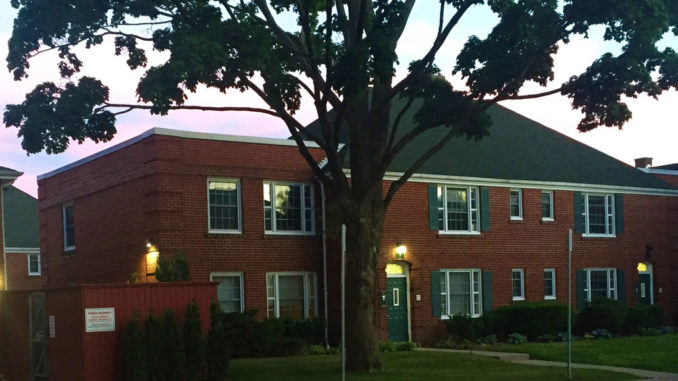
It’s been a long time, six years in fact, since this column featured Kelvingrove, Glen Leven and Strathavon (1325, 1351 and 1365 Bayview Ave.), the red brick, green roof apartments built in Georgian Revival style by Henry Howard Talbot, the builder-mayor of Leaside.
Six years ago to the month, tenants were served with a “Notice to Terminate a Tenancy at the End of Term for Conversion, Demolition or Repairs,” effective August 31, 2013 in order to upgrade the interiors. The construction renovations were to include new interior finishes and materials, new windows, washrooms, electrical system including the removal of knob and tube wiring, new heating/ventilation system, and utility metering. This followed a four-year (2006 to 2010) fight by the owner, a Government of Manitoba pension fund, to demolish the three rental apartment buildings and build condominium townhouses on the site (and a new apartment building to replace the rental units). The tenants, with the support of the Leaside Property Owners’ Association (LPOA) and the City of Toronto, won a rare victory at the Ontario Municipal Board, which decision the owner appealed to the Superior Court. Ultimately, the tenants, the LPOA and the City of Toronto prevailed.
The Talbot apartment properties are important to Leaside not only because they are heritage designated, but because they provide relatively affordable accommodation.
Six years ago we had several concerns about the en masse eviction of tenants rather than a phased eviction that would potentially allow for tenants to stay within the complex. Requiring tenants to vacate can amount to a permanent eviction as many, particularly the elderly, are unable to bear the stress of relocating, moving out, and moving back, and having moved, do not move back. And we were concerned about maintaining affordability in Leaside’s increasingly unaffordable market, both rental and ownership.
So, what has happened since? Are the tenants back in their apartments enjoying their newly renovated suites? Not so much. In 2015 and 2016, after the renovations, some former tenants moved back, while a majority of the units were rented to new tenants. However, it appears that the renovations were incomplete; the tenants have been experiencing a state of ongoing repairs that relate more to renovation deficiencies than typical maintenance. The deficiencies include HVAC, electrical, plumbing problems, issues with interior finishes, flooring materials, windows, cracks in walls, as well as exterior fire escape stairs, cracks in the concrete and foundation walls, and basements left unfinished in a state of disrepair. And tenants have discovered City building permits from 2013 that are still open!
What about affordability? In 2018, the owner applied to Ontario’s Landlord and Tenant Board (LTB) for an Above Guideline Increase (AGI) to rents, to pay for deficiencies in apartments which the tenants were led to believe had been fully renovated. The tenants formed a group, called “WeRock Tenant Association of Kelvingrove” to fight the increase at the LTB’s mediation hearing on January 30, 2019. However, the LTB’s decision received in March means that the rent has been increased by 4.96% (0.26% for property taxes plus 2.9% for capital expenditures, plus 1.8% provincially mandated rent increase) for the period of June 1, 2018 to May 31, 2019. Tenants feel the board has allowed the owner to charge tenants for the costs of a botched renovation job, rather than absorbing the costs themselves.

Tenants also have another quite fundamental concern – they feel the landlord has failed to embrace and respect the heritage character of the buildings, and there is little recognition or acknowledgement of the heritage designation when doing past or present renovations. This is not a new problem – there was quite a fight when the owners of nearby Garden Court Apartments, also a heritage designated property – tried to change the metal frame windows without consulting the tenants. In that case, the end result was a sympathetic change; let’s hope that sensitivity can be worked on in this case.
Note: I wrote to the owners of the apartments for comment. Here is the response, from Mark Hales, P.Eng., senior vice president, construction & property standards with Realstar Management:
“Most of the buildings at Kelvingrove Apartments were constructed over 80 years ago. As with any property, capital investments are periodically needed to preserve aging buildings and infrastructure. Above Guideline Increase (AGI) rent applications are based on provincial legislation, are not automatically granted, and allow only certain capital expenditures for consideration. Each application for an AGI is carefully reviewed by the Landlord Tenant Board, which is an independent board that is not partial to landlords or tenants and which determines whether capital investments are eligible grounds for inclusion in an AGI. This formal process includes the opportunity for tenants and others to participate in the decision. AGIs that include property tax increases receive similar review/scrutiny from the Landlord Tenant Board. This process was followed during our recent AGI application for the property. Tenants were in attendance, had legal representation present, and elected to participate and agree to the AGI presented at the hearing.”


